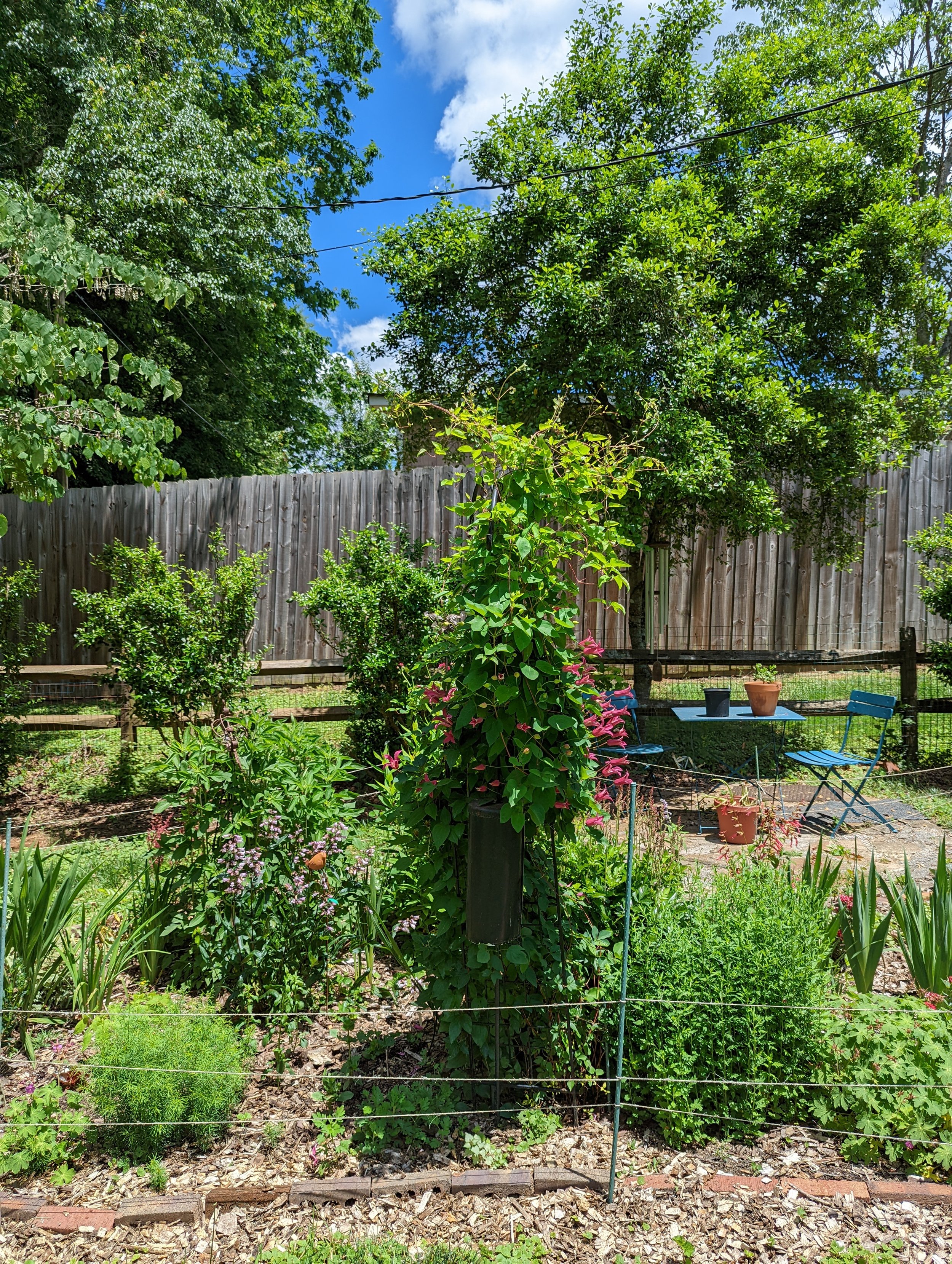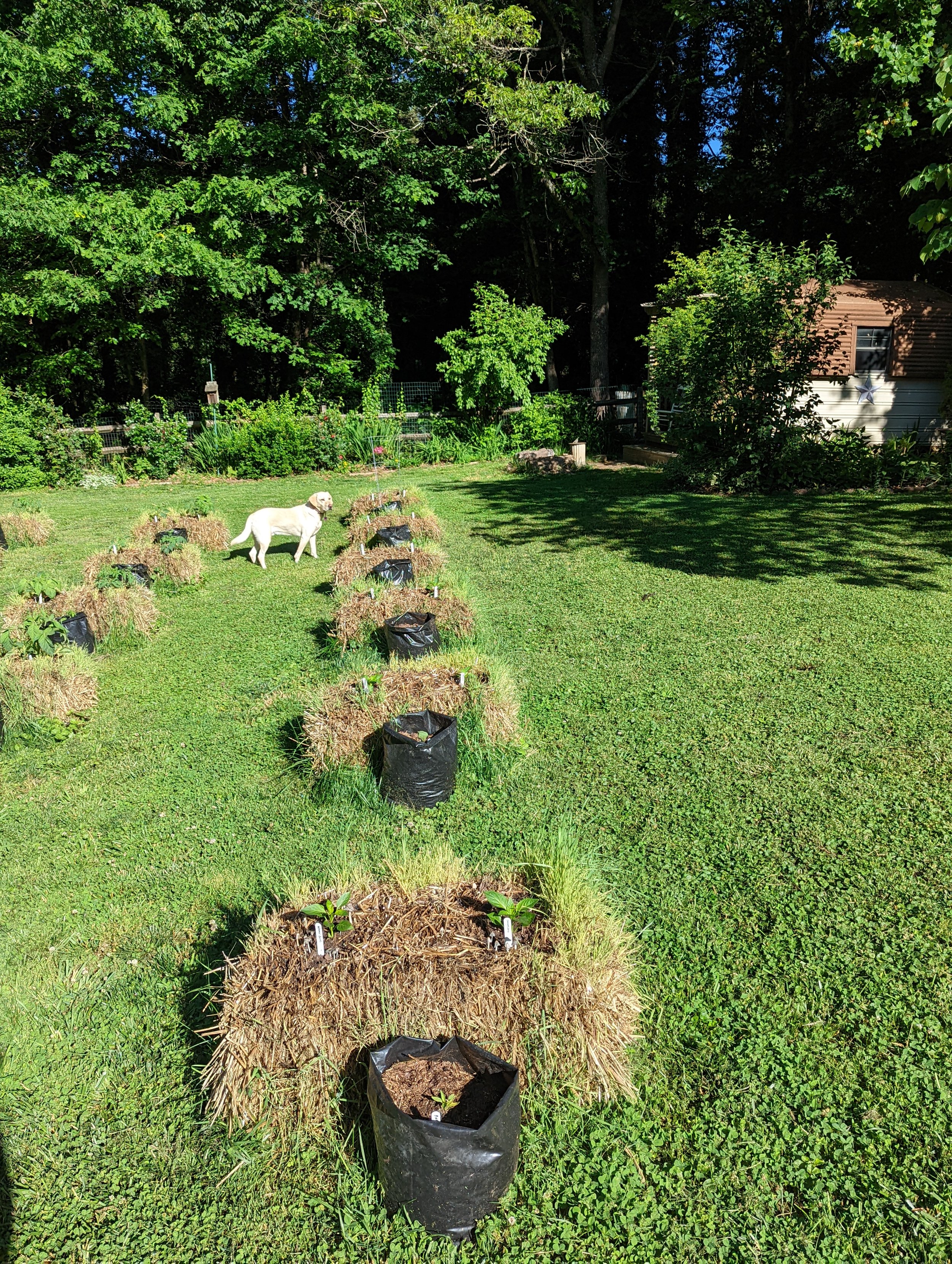Husker’s Red penstemon in bloom in our flower garden, end May 2022
I really love reading through Carolyn and my garden updates in these old OTVs. It reminds me, again and again, of how we really were true explorers of the many varieties coming into the SSE yearbooks, but also how we ended up being the source of varieties into the yearbooks as well. Read on to find out how Carolyn made her challenging choices of what to squeeze into her tomato garden.
_____________
Many are Called; Few are Chosen
by Carolyn
It could be worse. I could be addicted to heroin, crack or alcohol; as it is I’m addicted to heirloom tomatoes! The major agony of early March is to decide which seeds get planted and which get to stay in their little packets, passed over once more.
To put the situation to perspective, I have seed for about 1000 varieties of which I’ve grown out maybe 5-600 varieties. Since I much prefer to grow out something new, something not listed in the SSE Annual, it means that it will be a long time until I get to some of those others. Let me explain, by going through my mental reasoning this year, how I select which varieties to grow.
I have before me my grow out list as a reference. The first 40 were a snap, so to speak. I like to recycle the seed I’m offering through SSE every five years so I had to look at the 1991 varieties and decide which ones to keep going and which ones weren’t requested. Not a problem. Then I had to inventory the 1992, 1993, and 1994 seed to see which varieties were depleted. Magnus was planted for a closer look (up and giving both potato and regular foliage), Orange Strawberry and Hillbilly Potato Leaf to see if they are true, Cuostralee Pink to confirm it really is a single mutant of the red variety, which was also planted, and Aunt Ruby’s German Green (1993 seed) because I found out in December of 1994 that someone growing out my 1994 seed found it wasn’t pure. Remember from the last issue of Off the Vine how I described the seeds from the “monster” tomato which the mice ate? Well, I’d saved seeds from sister fruit and in they went along with the orange/red Brandywine F3 seeds described in the last issue of Off the Vine.
Next came the various crosses used to offer the F2 seed to you readers. I had forgotten to save seed last year of the Yellow Oxheart X Ukrainian Heart F1’s and had not grown the Brandywine X Kotlas crosses. Finally, two new crosses of Stanley Zubrowski’s, which neither Craig nor I grew last year, were planted. Next came a bunch of Craig’s favorites which I hadn’t grown out yet and then a few Amy Goldman brought back from France when she was there for the annual Fall pumpkin festival. Next came some interesting ones of French origin from an English SSE member and Off the Vine subscriber. And the subtotal on the above was 72.
Omar, an adjunct who taught Biology Labs for us went home to Lebanon to sell the family hotel on the Mediterranean and as he promised, came back with seeds for a huge pink the farmers in the Lebanese hills grow. And my student Heidi went home to Cameroon, Africa and over the Xmas break and brought back a hot pepper and one tomato variety. Then came a series of varieties sent to me by Off the Vine readers and from the descriptions, many of these sound great! None of them is listed in SSE. Of course I planted all the newly offered SSE Russian varieties. Next came varieties from Bill Minkey. Now the subtotal is about 110. Whoops! I almost forgot to plant the varieties I’ll need for the 1850’s vegetable garden I do for the local Shaker Heritage Society so in went Riesentraube, King Humbert, Green Gage, Eearly Large Red and Red and Yellow Pears. Whoops again, I’ll need some greens, whites and bicolors in the tomato patch for the several field demonstration days I do in the fall. So White Queen, Green, Evergreen, Green Grape, Isis and Marizol Gold go in next. I asked Craig if he would obtain the seeds from the USDA this year because I was so busy with the new Off the Vine requests, renewals, etc. I told him what I wanted and he decided on the rest. I only planted 32 of the USDA varieties; the commercial heirloom types and the ones with names that amused me like Victorian Dwarf, Cream City and Ham Green Favorite. I cannot explain to myself why I sowed something called Potato Leaf; I can’t believe I did that. Then I had to plant some favorites like German Red Strawberry, Manyel, Kellogg’s Breakfast, Large Pink Bulgarian, Bulgarian Triumph, Aunt Ginny’s Purple (which I totally forgot to list in SSE this year), Opalka, Martino’s Roma, Galina Ivory Mutant and Crnovic Yugoslavian, to name a few. My list ended there but then a few more varieties trickled in and I just had to sow them. Final damage count? About 160 varieties.
In Craig’s article he discussed whether or not to plant original or saved seed. I always plant saved seed when I have a choice because it’s the only way of finding out if the seed is pure. Two years ago I started listing next to my name in the SSE Annual the varieties I subsequently determined to have been sent out crossed. Since I certainly am not growing everything in 1995 that I grew in 1994 I would appreciate any feedback that any of you might give me.
The limitation I have on how many varieties I grow relates to the amount of bench space made available to me by the commercial farmer who lets me do my transplanting at his greenhouses and then grows on the plants for me. He’s a terrific grower and since he started growing the plants for me I’ve had no cutworm damage in the field because the stems are so stocky. I have no limitation on field space, and I do have help with the initial cultivation and fertilization of my plants, but there’s still a lot of hoeing and weed pulling to do. Yes, it’s hard work, especially with my annoying arthritis, but I can’t wait to see what the foliage will be like, and the blossoms, and finally the fruit shape and color. It’s the “possibilities” that lure me and hold me and make each summer so wonderful and challenging.
_________________
That was a fascinating read (as always!). It is interesting to read the history of what was named Omar’s Lebanese - a huge, pink delicious tomato that Carolyn was responsible for popularizing after she received the seeds. Reading about how Carolyn decided what to grow was illuminating - and fun!
Sugar Snap Peas - we are just starting to pick them, beginning end May 2022





























